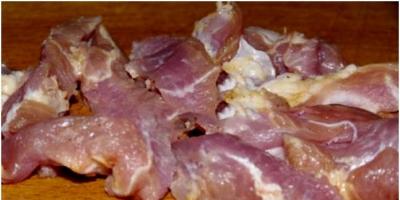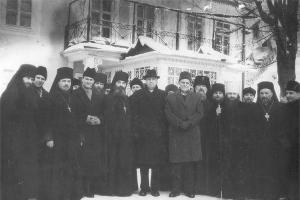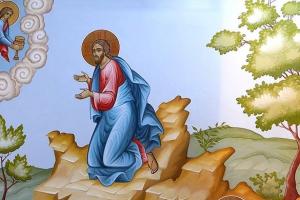The main story of the Old Testament is full of the protective care of God the Father for his long-suffering people. This closeness was especially evident in the closeness to the prophets, who conveyed God's Word to true Christian believers and those who had just come to know faith in God. On the holy icon of God, the Father is depicted as an old man who sits on a throne in a majestic and calm manner.
Both His hands are raised. His face is bordered by a long gray beard. As in all images of the Savior, his hair falls onto his shoulders. The vestment on the icon of God the Father consists of a tunic and a chiton reaching to the ground. All the folds of the elder’s clothing are pierced with thin golden rays of the sun, symbolizing the radiation of divine energy forces. Around the head of God the Father is a halo, which is depicted only by God the Father and Savior.
This ancient icon was for some time banned by the VII Ecumenical Council, which was convened against the heresy of iconoclasm. In the Russian Church, such images were condemned for the second time by the Great Moscow Council in the 17th century. Nowadays, the icon of God the Father exists in Orthodox iconography, despite the fact that in church prayers and Orthodox services they glorify God the Son.
The presence of the icon of God the Father in Russian churches
For more than four centuries, the image on Christian icons
God the Father adorns many churches not only in Russia. In addition to the famous and very ancient icon of the Fatherland, icons with His image can be seen on some famous ones. So worth noting brilliant paintings Intercession Cathedral in Moscow, in which you can see artistic icon paintings depicting God the Father, whose ancient icon is called the icon of Hosts.
If we discard the incessant disputes between priests and iconographers about the legitimacy of this image, then we can say with confidence that this image is worthily one of the main decorations of Orthodox monasteries. Nowadays, new versions of this shrine are being created, skillfully embodied in icons made of amber, icons embroidered with beads or painted in a typographic way. You can buy an icon of God the Father created by modern icon painters in online stores. Vintage lists of this famous icon can be seen in antique stores and at exhibitions of leading collectors.
Christians around the world consider Jesus Christ not just the Son of God, but the incarnation of God in earthly matter. Indeed, Jesus Himself said:
“He who has seen Me has seen the Father”(John 14:9).
It is in the incarnation of God in an image that could be seen that a significant part of Orthodox theologians see the basis of icon veneration. Orthodox theologian L. A. Uspensky (1902 - 1987) wrote in his book “Theology of the Icon of the Orthodox Church”:
“The image is inherent in the very essence of Christianity, for Christianity is the Revelation not only of the Word of God, but also The Image of God revealed by the God-man Jesus Christ. The Church teaches that the icon is based on the very fact of the incarnation of the second Person of the Holy Trinity».
That is, allegedly, God was not depicted before only because He was not seen. It turns out that in chapter 4 of the book of Deuteronomy, the Creator, speaking about the fact that He did not show himself to people so that they would not make images of Him, limited this prohibition to the time of the coming of Christ:
« Hold firmly in your souls that you have not seen any image in the day that the Lord spoke to you at Horeb out of the midst of the fire, lest you turn corrupt and make graven images for yourselves, images of some idol representing a man or a woman» (Deut. 4:15,16).
Now, having seen God in Jesus, people can supposedly forget the prohibitions of the Holy Scriptures regarding images and images. On this topic, in addition to what was mentioned above, there are many more lengthy works of Orthodox fathers, the meaning of which boils down to the fact that with the coming of Christ, for closer contact with God it became possible use images of His Son.
However, this theological position is not consistent with the teachings of the Old and New Testaments. The entire Bible is consistent on the issue of idolatry. As we have already seen, in the Old Testament the prohibition against idols and images was given to the Jews at Mount Sinai. God considered this commandment so important that he included it in the Decalogue. Further, Scripture more than once called the idolatry of the people of Israel fornication against the Lord. New Testament continued to warn against idolatry. The Bible ends with a list of sins that will not allow many people to enter the Heavenly Jerusalem, among which is the violation of the second commandment of the Decalogue - the veneration of idols.
"Blessed are those who keep His commandments so that they may have the right to the tree of life and enter the city through the gates. And outside are dogs and sorcerers and fornicators and murderers and idolaters, and everyone who loves and practices iniquity"(Rev. 22:14,15).
The book of Revelation clearly shows that idolatry will develop at the end of earth's history. What kind of obnoxious service to God does the last book of the Bible speak of? Indeed, today on the planet it is already relatively rare to find pagan gods in the form in which they existed in biblical times. However, this sin in the Apocalypse is significant and stands out from the rest:
“The rest of the people who did not die from these plagues did not repent of the works of their hands, so as not to worship demons and gold, silver, copper, stone and wooden idols who can neither see, nor hear, nor walk"(Rev. 9:20).
If we take into account that according to the book of Revelation at the end of earthly history from God's judgments Babylon fell, the great harlot, who gave the wine of her fornication to drink all nations (see Rev. 18:2, see also Rev. 14:8, Rev. 17:2), it becomes clear that there will be many erring believers before the Second Coming of Christ so many (got me drunk all nations ). So, to the above idols The revered idols of historical Christian denominations may well also apply.
The teaching of Orthodoxy regarding the veneration of icons as a whole lacks consistency. On the one hand, the popular church teaches: the image of the face of Christ became pleasing to the Creator, because the second Person of the Divine Trinity was incarnated on Earth in the image of Jesus. On the other hand, according to church tradition, the first icon was not the face of an adult Jesus, but Luke’s image of Mary with a baby. And subsequently, icons in which the image of Christ was completely absent became revered. The naivety of the legends about the icons and the time of their appearance are also striking. The first to mention the icon of the Mother of God painted by the Evangelist Luke in the 6th century is the historian Theodore the Reader. He writes that Empress Eudokia sent from Jerusalem to Constantinople her sister Pulcheria the image of the Mother of God, painted by the Evangelist Luke. According to church tradition, the icon painted by Luke was in Constantinople until the 15th century. Then, according to one of the legends, before the fall of Constantinople to the Turks, the icon disappeared from there. Then she miraculously appeared in Russia, transported over the waters of Lake Ladoga. Now this icon is called the Tikhvin Icon of the Mother of God.
However, it is not easy for Orthodoxy to answer many questions:
Why does mention of the existence of an icon painted by Luke begin only in the 6th century?
Why was this icon not shown at the councils of 754 and 787 during iconoclasm in defense of icon veneration?
Could Luke have seen young Mary with baby Jesus?
If Luke painted a portrait of Mary, then why did the most influential preacher, Christian theologian and politician Blessed Augustine (354 - 430) write: “We do not know the face of the Virgin Mary, from whom Christ was born, unmarried and incorruptible, miraculously”?
If this icon was really painted by Luke, then it should be one of the greatest shrines of the entire Christian world. Why are there no pilgrimages to her for millions of Christians?
Why, according to church traditions, are there many icons claiming to be painted by Luke: the Merciful (Kykkos) on the island of Cyprus, the Czestochowa in Poland, the Philermos in Montenegro, the Great Cave on the island of Patmos, the Vladimir, Smolensk, Blachernae, Jerusalem, Korsun (Ephesus), Fedorov, Madonna di San Luca, Tikhvinskaya in Russia and others? Although the first legends mention only one icon of Luke.
Why aren’t independent examinations of this or other icons, supposedly Luke, carried out to establish their true age? After all, if these icons were painted at the time the New Testament was written, then it will be proven once and for all that icon veneration existed in biblical times, moreover, among the apostles. Why aren't examinations done? Is it because the legend is very unreliable? Maybe church representatives are not trying to confirm it, knowing the result in advance? After all, even a passing glance from a specialist is enough to understand that the style and method of writing these icons differs significantly from the catacomb visual art of Christians of the first centuries and even from the iconography that has come down to us from the 6th century. And they are very well preserved for being two thousand years old. The obvious dubiousness of the legend about the icons of Luke is confirmed by the famous Orthodox figure Archbishop Mikhail Mudyugin (1912 - 2000), Doctor of Theology, professor, rector of the St. Petersburg Theological Academy in his book “Russian Orthodox Churchness. Second half of the twentieth century" (chapter "Icon veneration"):
« Insolvency This apocryphal legend is confirmed by the number of icons of the Mother of God attributed to the evangelist: there are about two hundred of them, which significantly exceeds the physical capabilities of one person, mainly engaged in medical (Col. 4:4), missionary (he is a companion of the Apostle Paul, see Acts 16: 13; Acts 20:5,6; Acts 27:1,2) and literary activity (the Apostle Luke, as you know, is the author of not only the Gospel that bears his name, but also the New Testament book “The Acts of the Apostles”). In addition, the icons attributed to St. Luke very varied in manner of execution, some of them wear clearly Byzantine features, others (especially numerous) - Old Russian style, some allow us to easily establish the presence of Western influence.”
It will also be very interesting to hear the answer of official Orthodoxy to the question:
Why does the Orthodox Church turn a blind eye to violations? direct prohibition of the Bible - an image of God the Father? We have already seen that in the book of Deuteronomy in ch. 4 tbsp. 15 The Creator said that He did not show himself to people, lest they make images of Him and worship him. Moreover, the Creator noted: "Man cannot see Me and live"(Ex. 33:20). In the New Testament, the Apostle John reminds: “No one has ever seen God”(John 1:18, see also 1 John 4:12, 1 Tim. 6:16). As we know, Orthodoxy believes that the Creator lifted the ban on the image of God the Son by revealing Him. But God the Father Himself never showed Himself to people. This means, following the logic of the popular church, God the Father was never affected by this exception. Then it is not clear why Orthodoxy at the same time extended the “exception” in relation to Jesus to the veneration of images of God the Father and other personalities - holy people and Mary, in direct violation of God’s law (see Deut. 4:15, Exod. 20:4,5) . Today, many icons revered by the official church depict God the Father. For example, He is painted on the miraculous icon of the Sovereign Mother of God above the Mother of God. The image of the Father is present both in the icon of the Holy Trinity and in other images of the New Testament Trinity. And icons depicting Mary and saints are found in every Orthodox church and in almost every Orthodox family.
There are also questions to which the popular church finds it difficult to find logical answers:
Why history does not know the shrines of the 1st - 5th centuries similar to modern icons, except for several icons attributed to the hand of Luke, but, let us recall, far from the style of the fine art of that time and not having the conclusion of independent examinations confirming their two-thousand-year age? It is worth recalling that authoritative representatives of Orthodoxy admit that the earliest works of Christian fine art that have come down to us are the paintings of the catacombs of the 2nd – 4th centuries. (see chapter And « Historical information» to this chapter).
Why not not a single one archaeological fact confirming the use of images by the first Christians for worship of God, but there is only evidence of the use of wall and decorative paintings?
Why does history not know theological and chronicle sources of the first three centuries after Christ, which speak of Christians’ veneration of images and other shrines or the need for such veneration? At the same time, let us recall that there is a lot of documentary evidence to the contrary, some of which we discussed above in the chapter "Images in the Bible and Meeting Houses of the Early Christians".
Some representatives of Orthodoxy claim that they do not worship icons in the form of objects, but through these images, as through a “heavenly” window, they address directly those who are depicted on them. Then the next question is logical:
Why, among several icons of the same “hero of faith,” are some more revered and others less? It turns out that not the saints themselves, but still their Images“miraculous” in different ways. And the point here is not that some images are more prayed for, while others are less... After all, some icons supposedly immediately “exuded grace.” A clear example of this is the icon of the Kazan Mother of God, which, according to church tradition, immediately began to “work miracles” after its appearance.
Is it possible to portray God the Father?
IN Lately We increasingly hear opinions about the incompetence of this image. Since fallen man on his own cannot understand this or that church issue, according to the advice of Holy Scripture: “Put everything to the test; stay good" last. to Thessan, chapter 5, article 21, we will try to understand this issue.
For an Orthodox Christian, there are three divine sources that are indisputable authority: this
1) Holy Bible
2) Sacred Tradition
3) Patristic heritage
In order, let us first turn to the Holy Scriptures of the New Testament.
The Gospel of John, chapter 1, v. 18 says, “No one has ever seen God. Only God is the only Son who is next to the Father - He revealed Him to us.”
The Lord Jesus Christ Himself testifies: “Everyone who has heard the Father and learned from him comes to Me. This doesn't mean that has anyone seen Father. Only He who came from God, He alone saw the Father.” Ev. from John chapter 6 v. 45-46.
At the request of the Apostle Philip to show the Father, the Lord reproaches him: “I have been with you for so long, and you do not know Me, Philip? He who saw Me saw the Father. How do you say: “Show us the Father? John ch. 14. Art. 8-9 i.e. if you want to see the Father, then look at Me. Therefore, those who want to see the Father should look at the icon of our Lord Jesus Christ.
The Apostle Paul in his letter to (Colossians 1.15.) says: “Christ is the image invisible God. In the letter to (Timothy 1.17.) he says: “To the everlasting King, immortal , invisible, to the only God be honor and glory forever and ever! Amen." (Tim. 6.16.); "He lives in an unapproachable light - His no one saw from people and can not see. To him is honor and eternal strength. Amen."
And so the Holy Scripture of the New Testament speaks of the indescribability of God the Father.
Let us turn to the second source, the Holy Tradition of the Church.
“Why don’t we describe the Father of the Lord Jesus Christ? Because we haven't seen Him. And if we saw and knew Him, as well as His Son, then we would try to describe and pictorially depict Him (the Father) too...” (Acts VII Ecumenical Council, Act 4) - say the fathers of this Council.
The Council of the Hundred Heads, convened in Moscow in 1551, giving instructions to icon painters, defined in its 43rd rule the fundamental non-representability of the Divine. This was also confirmed by the Great Moscow Council, which met in 1666-1667. In Chapter 43 of the Acts of this Council, which is called “On Icon Painters and Hosts,” a very clear decree was given: “from now on, the image of the Lord Hosts should not be painted in absurd and indecent visions, for no one has seen Hosts in the flesh, as is being painted, that is, depicted according to the flesh, and not according to the Divine. The Lord of hosts is gray-haired and the Only Begotten Son in His womb to write on icons and a dove between Them is extremely absurd and indecent.”
So, the anthropomorphic image of God the Father, St. He was always rejected by his fathers, and they considered it ignorant to portray such images. Moreover, the icon performs doctrinal functions, so a falsely understood image is dangerous, because it carries distorted information and becomes heretical.
The Fathers of the Great Moscow Cathedral, who gave an unequivocal order to remove images that do not correspond to Orthodox teaching from churches and prayer houses.
The Holy Synod of the Greek Orthodox Church in 1776 made the following decision: “The Council decided that this supposed icon of the Holy Trinity is an innovation, alien and not accepted by the Apostolic, Catholic, Orthodox Church. It penetrated into the Orthodox Church from the Latins.”
On I -th Ecumenical Council in Nicaea in 325, the heretic Arius told the fathers of the Council that since He is the Father, it means that He is older than the Son, therefore the fullness of divinity is not in the Son. The Holy Fathers of the Ecumenical Council answered him that in terms of humanity the father is older than the son, and in terms of divinity They are Co-Eternal. This suggests an unambiguous conclusion that the icon of God the Father in the form of an old man preaches the Arian heresy, which was cursed for I -th Ecumenical Council, distorts the feeling of the heart, communicates to the heart the fruit of our imagination, fills a person with a Catholic mentality.
Unfortunately, even the Law of God says that His, i.e. The Old Testament prophets saw the Father in this form. What to answer to this...?! All that remains is to turn to the liturgical texts, which, according to Hieromartyr Hilarion (Trinity), are the source of the unclouded, pure theology of the Catholic Orthodox Church.
“The Ancient of Days, Who gave the law of old at Sinai to Moses, today the Child is seen and according to the law, as the Creator of the law, fulfilling the law, is brought to the temple, and the elder is given...” the stichera at the litia of the Presentation. “Today Simeon rises into the arms of the Lord of glory, Who Moses first saw under the darkness, on Mount Sinai giving the tablets to Him. This One is the one who speaks the prophets and is the creator of the law...” stichera at the litany of Germanic Presentation.
“The Ancient of Days, having become a child in the flesh, the Virgin Matter is brought into the church of His law, fulfilling the promise...” Stichera on the Litany of the Presentation on and now. But I present the Irmos of the 5th song of the canon for the Presentation in Russian translation, so that it would be clearer. “When Isaiah saw in the type of God exalted on the throne, surrounded solemnly by the Angels of glory, he exclaimed: O wretched me ! I foresaw the future to come true God possessing unquenchable light and peace.”
“You were seen in the prophets, as mightily Jesus was, You were seen in ancient times, but now, in the Word of God, you appeared in flesh to the whole world by the will of the Virgin Mary, Christ, you showed your salvation to all who exist from Adam, as a Lover of mankind.” Verse on the Candlemas poem.
« God cannot be seen by man, but the angels do not dare to look at Him; By You, O All-Pure One, the Word incarnate as man, and magnifying Him, with heavenly howls we please You.” Irmos 9 songs of the canon
I think these texts are quite enough to be sure that all the divine visions of the Old Testament prophets related to the Second Hypostasis of the All-Holy Trinity, i.e. to our Lord Jesus Christ.
And the name “Hostes” means “God of hosts” or “God of armies”, refers to the entire Trinity, and not to one particular person (hypostasis), for it is said: “Holy, Holy, Holy is the Lord of Hosts...”
Now let us turn to the third source, to the holy fathers of the Church of St. John of Damascus teaches that God is depicted in the flesh only in the person of Jesus Christ, born of the Ever-Virgin Mary. Only in this case “the indescribable deity is described according to humanity.” St. Cyril of Alexandria writes about it this way: “What does it mean “he reached the Ancient of Days”—is it spatial? This would be ignorance, because the Divine is not in space, but fulfills everything. What does it mean “has attained to the Ancient of Days?” It means that the Son has attained the glory of the Father.”
Maxim the Greek rejected this icon, because he had never seen anything like it “in any land” and believed that the icon painters created this image from themselves.”
St. Basil the Great taught. “God has no outline. It's simple. Don't fantasize about His structure. Do not confine God to your bodily ideas, do not limit Him to the measure of your mind.”
And so we see that the icon of the “New Testament Trinity” and in particular the image of God the Father in the form of an old man is heretical and does not contribute to salvation, but removes it from it, because it is said that heretics will not inherit the Kingdom of God.
sexton Dimitri
God is completely incomprehensible in His being, incomprehensible in His essence and unknowable. As if dressed in the impregnable darkness of incomprehensibility. Not only are attempts to depict God in His being unthinkable, but also any definitions cannot embrace and express the essence of God; it is inaccessible to human consciousness, it is the impregnable darkness of the essence of God.
Theology itself can only be apophatic, that is, composed in negative terms: Incomprehensible, Inaccessible, Unknowable. Saint Gregory Palamas, in his defense of the Orthodox teaching about the uncreated light of Tabor, teaches us to immutably distinguish between the divine, completely unknowable essence and the Divinity in His action addressed to the created world, in His providential care for every creature. Palamas teaches to distinguish between the being of God and His divine energies-forces, radiations of grace that sustain the world.
The providential Divine action in the world is accessible to consciousness, cognizable, God addressed to the world, God extending His care, His love, His never-ending care to the world. This is wisdom that arranges everything, the light of the world that enlightens everything, the love of God that fills everything, this is the revelation of God - the manifestation of God to the world. And the world is designed by God in such a way as to perceive and accommodate this divine action, to take on this royal seal, to become entirely the royal property. The ultimate meaning and purpose of everything created is to become God's property.
The entire universe as a whole and each creation in its unique, inherent only features, conceal within themselves, as it were, some mysterious story about the Creator.
Therefore, it is incorrect to speak of God the Father as a hypostasis surrounded by complete darkness. From the very creation of the world, we see God the Father in His unceasing care for the world, in unceasing care for the human race and in unceasing communication with people, right up to His appearance, visibly and tangibly, to Abraham and Sarah in the form of one of the three Angels.
The entire Old Testament history of Israel is full of the protective care of God the Father for the chosen people. Saint Gregory the Theologian says this about Israel's communion with God the Father: "Israel was primarily turned to God the Father." And this closeness of the Lord of hosts to his chosen people was, first of all, closeness to the prophets. God the Father, as it were, allowed Himself to be contemplated, revealed His image with possible clarity, and perhaps one of the most complete revelations was given to the prophet Daniel in the vision of judgment, in which God the Father, as it were, spiritually outlines His image, reveals His Fatherly Face. Here is the prophetic testimony of Daniel (VII, 9, 13, 14): “I saw at last that thrones were set up, and the Ancient of Days sat down; His robe was white as snow, and the hair of His head was pure wool; His throne was like a flame of fire, His wheels are blazing fire... I saw in the night visions, behold, with the clouds of heaven came one like the Son of Man, came to the Ancient of Days, and was brought to Him. And to Him was given power, glory and a kingdom, so that All peoples, nations and languages have served Him; His dominion is an everlasting dominion, which will not pass away, and His kingdom will not be destroyed.” But only in the light of the Incarnation, and only in it, does the image of God the Father become possible.
In the service, in its visual part, we see a symbolic image of God the Father. At Great Vespers, while the clergy are singing “Bless the Lord, my soul... By wisdom you have created all things,” a priest, preceded by a deacon, comes out of the altar, through the royal doors, to burn incense, and walks around the temple. Here the priest signifies God the Father, who creates the universe, and is, as it were, an icon of God the Father Almighty, Creator of heaven and earth. But even in the visual part of the service, similar to the censing on “Lord, I cried,” we do not see a self-sufficient image of God the Father, but only in mutual relation to the other two hypostases or in providential care for the universe, and in this sense, the negative attitude of the Church Fathers to the image God the Father remains in force and acts in the Church, despite such a wealth of Fatherly images.
There is a prophetic definition, not rejected by the Church, that at the end of the ages a temple dedicated to God the Father will be erected. Great and glorious among all nations, this temple will be the possible fullness of the revelation of God the Father in the Church. Such completeness of the Father's appearance precedes the Last Judgment, where the Father transfers the Judgment to the Son, the Son judges the universe by the will of the Father.
Repeatedly and under different circumstances, the question arose in the Church about how the first hypostasis - God the Father - should be depicted, and whether the icon of God the Father even has a place in a number of church images. Judgments related to this issue were sometimes contradictory. And this inconsistency, it seems to us, is not accidental. This apparent duality is inherent in the very life of the “Fatherly” images.
The question of the image of God the Father already took place at the Seventh Ecumenical Council, although not as a formal discussion. And the judgments expressed by St. John of Damascus and St. Theodore the Studite, the great defenders of the veneration of icons, reject the image of God the Father. One of the main reasons for the rejection of such an image is that God the Father, depicted in human form, can create the impression or give rise to the idea of some of his primordial human-likeness. St. John of Damascus says: “We do not depict the Lord the Father because we do not see Him; if we saw Him, we would depict Him.”
From the words spoken at the Council in defense of icons, the Word of John of Thessaloniki attracts attention: “We make icons of those who were people and servants of God and wore flesh. In bodily form, we do not depict any incorporeal beings. But if we do icons of God, that is, our Lord and Savior Jesus Christ, then we depict Him as He was seen on earth, being among people.”
In the further development of consciousness associated with the veneration of icons, such a materialistic basis underwent significant changes. The circle of images included not only those who were people and holy servants of God and wore flesh, but also images of the Angelic world, images of Angels, which, even if they appeared in a visible image, this phenomenon could not be called “wearing flesh.” Rather, we can say that the Angels clothed themselves in a visible image as a symbol speaking of their incorporeal nature. Icons also arose that were not only pure evidence of what was unconditionally visible, but were rather filled with doctrinal and dogmatic content.
In Russia, at the Council of the Stoglavy (1551), the question of images of God the Father arose again. The council was presented for discussion with a letter drawn up by a certain clerk Viskovaty, in which this clerk questions the admissibility of images of God the Father. These doubts were apparently caused by the painting carried out in the newly built palace of Tsar Ivan the Terrible by Novgorod icon painters. Deacon Viskovaty presented a list of icons containing the image of God the Father and demanded their removal from church use. The clerk’s petition was considered separately, after the end of the meetings of the Council. Deacon Viskovaty was not recognized as right, and his petition was rejected. The decision was made in general terms, without considering each image individually. It seems that the providential significance of this decision lay in the fact that the Council, having accepted icons with very controversial iconography, preserved and accepted that icon, without which it is unthinkable to imagine the Church. This is an icon of the Holy Trinity - the Trinity of Abraham, as defined in the charter of clerk Viskovaty. This icon was included in the list of those subject to confiscation on the grounds that it contains an image of God the Father. Stoglav approved the image of the Trinity with special permission.
A few years later, the next discussion of images of God the Father took place at the Great Moscow Council (1655). This Council, in contrast to Stoglav, completely rejects the image of God the Father, making an exception only for images of the Apocalypse, where it considers the image of God the Father acceptable “for the sake of the visions there.” For the sake of the visions of God the Father in the form of the Elder, the Old One, given in Revelation.
The prohibition of the Great Moscow Council is of a warning nature. The Council's concern is determined by the fear that the human image of God the Father may inspire the idea of the human-likeness of the first Person of the Holy Trinity. The Great Moscow Council also points out the inadmissibility of the icon, which bore the name “Fatherland” and was widely distributed.
This icon is placed in the upper paternal rank of the iconostasis; it, as it were, overshadows the entire temple, and according to the iconographic plan, it strives to most fully express the paternal nature of the first Person.
This icon is very ancient in origin - the first of the surviving images dates back to the beginning of the 11th century and is preserved in the Vatican Library. This is a miniature placed in the manuscript of John Klimach (from the book by Adelheim Gaiman). Its iconography is completely established and complete and differs little from the icons of the 16th and 17th centuries that were placed on iconostases.
God the Father is depicted as an old man sitting on a throne. The appearance of the old man is majestic and calm, both hands are raised in blessing. The face is bordered by a gray, rather long and somewhat forked beard. The strands of hair are also divided in two in the middle, as is usually depicted by the Savior, and fall over the shoulders. The facial features are solemnly blissful. The vestment consists of two clothes: a tunic that falls to the ground, and a chiton - a robe similar to the one in which the Savior is depicted. All folds of the robe of God the Father are pierced with thin golden rays, asist, signifying the radiation of divine forces-energies. These rays cover the upper and lower garments of God the Father and the throne and the footstool. The head of God the Father is crowned, according to church regulations, with a halo, usually inherent in the image only of God the Father or the Savior, where He is depicted in the glory of the Father, for example, on the icons of the Angel of Silence, the Old Denmi. The crown consists of two squares: one is fiery, testifying to the divinity of the Lord, the other is black-green (or blue-black), signifying the darkness of the incomprehensibility of the Divine. Such a crown, but not in the form of a halo, covering the entire image, is found on some icons of the Mother of God, for example, the Burning Bush. The Eternal Infant God the Son is depicted on the knees of God the Father. His robes, just like the Father's robes, are illuminated with golden rays - asist. The head is crowned with a crossed halo. The head of the Divine Infant rests erect, his facial features are commanding. The forehead is disproportionately large to commemorate divine omniscience. The position of the body of the seated Infant of God is as free and majestic as the position of the Father’s body. In the bowels of Emmanuel the Holy Spirit is depicted in the form of a dove. The Holy Spirit is surrounded by a sphere of blue color, permeated with rays emanating from Him. The Savior usually holds the sphere surrounding the dove with both hands. Sometimes the Savior is depicted with two blessing hands, like the Father.
If we return to the “Fatherland” icon and look closely at its construction, it becomes visible how this icon strives to become an icon of the Trinity and cannot completely become one. In its construction, it incorrectly matches the images of Faces. The main movement of this image is, as it were, a movement inward. God the Father in the form of an old man seems to completely absorb the images of the Son and the Holy Spirit with His majestic outlines. And the Holy Spirit, depicted in the form of a dove, is immeasurably diminished in relation to the first and second Persons. The result is an image of the Trinity, directed, as it were, into Itself, in which the dignity of the Persons is consistently diminished. Just as, for example, the image of three Persons on the cross, in which the Lord of hosts, placed at the top of the cross, blesses, and the Holy Spirit overshadows the crucified Lord with the wings, does not completely and in its entirety constitute an image of the Holy Trinity. The same can be said about the icon, often placed in the iconostasis, “Seating at the right hand of the Father,” or, as it is often called, the “New Testament Trinity.”
The basis of this icon was the desire to depict the Lord Jesus Christ upon His Ascension, seated at the right hand of the Father. God the Father is usually depicted on the right side of the icon in the image of an Elder sitting on a throne, wearing royal robes, illuminated by rays, and wearing a royal crown. The Father holds an orb in his left hand. The head of God the Father is surrounded by an eight-pointed halo, inscribed in a round halo. Right hand Usually God the Father blesses Christ, whose image is placed on the left side of the icon. The Savior, just like God the Father, has a royal crown on his head, and His head is surrounded by the usual baptized halo for the Savior. Christ's clothing is similar to the Father's clothing. Christ's face is turned to the Father and, as it were, receives a blessing from Him. At the top is placed a dove enclosed in a triangle or in a round sphere - the Holy Spirit.
In this icon we see how, due to some internal need, the “Seating at the right hand of the Father” icon turned into the “Trinity” icon, and just like the “Fatherland” icon, it did not fully express the image of the Trinity. Looking at the main outlines of this icon, you see how diminished, how inferior is the place occupied by the image of the Holy Spirit, which is the connecting principle between the images of the first and second Persons and is deprived of a completely hypostatic image. But God the Father is depicted with the same material force as Christ, and such materiality of the image, according to the judgment of many Church Fathers, can give rise to a false idea of His nature. And here we see the same impossibility of creating an immutable and completely perfect image expressing an event.
In the same way, or even more controversially, the Faces of the Holy Trinity are depicted on the star and in many other cases, for example, on the antimension. The Holy Trinity, although represented by a direct or often symbolic image of three Persons, does not find Its completely unconditional image.
Looking at the “Fatherland” icon, you see what insoluble, what painful difficulties arise in the Church in connection with the image of God the Father and especially with this image. The image of God the Father, the emergence of which was born out of some need to have such an image, does not seem to fully find itself right place. If we present the images of the First Person as independent images, the measure of abstinence regarding the image of God the Father that the Church adheres to would be violated. And indeed, in the Church there was not and there is no such self-sufficient icon of God the Father, just as there is no dedication of a temple to God the Father, or a holiday in which the celebration would relate directly to the Father. And due to this dispensation, the very image of God the Father gives rise to the need not to be isolated, but to be depicted with the second and third Persons of the Holy Trinity, with the Son and the Holy Spirit...
The need to think of God the Father not in isolation is in no way false; it is the very life of the Church and will never dry up. The need that creates the image of the Trinity, emanating from the image of God the Father, does not find a completely correct solution. Such an image of the Holy Trinity is not clothed in heavenly glory, does not shine with equal unity, and becomes a mountain without a snow-white peak. Here we see some, as it seems to us, insurmountable incompleteness, which lies in the fact that the equality of the Persons of the Holy Trinity does not find its expression. In all these constructions, the third hypostasis - the hypostasis of the Holy Spirit - is not depicted personally and does not have the fullness of hypostatic dignity. In all these icons, the Holy Spirit is invariably depicted in the form of a dove, and this image cannot be equal to the image of the Father and the Son, for whose images the image of a person is taken. And therefore, all the so-conceived icons of the Trinity, not devoid of meaning in themselves, cannot become that immutable full-fledged icon, that holy seal that fully imprints the dogmatic confession of the Trinity.
The judgments of the fathers regarding the images of God the Father on icons, adopted by the Seventh Ecumenical Council, are negative. The Council recognizes that it is inappropriate to depict the Father, Whom, according to the Savior, no one saw. In the judgment of the fathers, the image of God the Father is not recognized as appropriate or even acceptable. And at the same time, the Church is full of images of the Lord of hosts. We see images of God the Father in the temple painting, in the dome of the temple, on the iconostasis in the rank of the forefathers, in many icons, such as “Epiphany”, “Fatherland”, “Trinity”, “God of Hosts in Glory, Seated on the Cherubim”. These icons are found everywhere where there is an Orthodox Church, and belong to different times. There are Byzantine images from the 11th and 12th centuries and later, and many Russian icons from different times. The 16th and 17th centuries are, apparently, particularly iconographically rich in terms of the image of God the Father.
How to explain this seemingly irreconcilable contradiction? Are all these images heretical, false, completely alien to the Church and, thus, subject to confiscation and complete destruction, or is the prohibition of images of God the Father not unconditional? One must think that the prohibitions on depicting God the Father are not ontological in nature, they are not prohibitions that, in their very essence and completely, deny the possibility of depicting God the Father, but are restrictive, ascetic measures, with the goal of imposing a fast on images of God the Father. .
The first and main reason for such a restriction, it seems, was the need to firmly establish the foundation on which the veneration of icons rests. Ground approved by the Seventh Ecumenical Council, - the dogma of the Incarnation. This is the basis and affirmation of sacred images: God, who cannot be described as Deity, became describable as flesh, and since the invisible Deity became visible and tangible flesh, to that extent it can be depicted and described. The image of Christ - the imprinted hypostasis - unites two natures together, and this incarnation of God is for us the basis of the icon, like the icon of icons. Just as a stone placed at the head of a corner brings together two walls of a building, Christ, the incarnate Word, unites with Himself two unmerged hypostases: the indescribable Divinity and the describable humanity. And in this sense, the veneration of icons became possible only by Christ and through Christ, and there can be no other basis. The image of the God-man Christ became a sign of church victory and the foundation that the Savior Himself gave to the Church, imprinting His image on the ubrus. And the Fathers of the Church, who defended the veneration of icons, invariably affirm this unshakable foundation with their labors. The icon of God the Father is conceivable in the light of the icon of Christ. In the minds of believers, a split could occur, as if the image of Christ was doubled with the image of God the Father. The prohibition on depicting God the Father is reminiscent of the Old Testament prohibition on creating sacred images. Both here and there, this prohibition does not deny the possibility of images in their very essence, but imposes a ban on sacred images, similar to the prohibitions of fasting in relation to food. Fasting does not essentially cancel the eating of food, but it does keep one from eating it for a while. And just as in the Old Testament the image of Cherubim in the Tabernacle of the Covenant was an exhaustion of the prohibition of sacred images, so in the New Testament Church the custom of placing images of God the Father on icons, which had firmly entered into church life, had already deprived the prohibition of its immutable character, made it as if clarified, not completely impenetrable. These decrees began to resemble a curtain that does not allow light to penetrate in full force, but is not a source of complete darkness.
We see the same thing in the liturgical system. The Church does not know holidays dedicated exclusively to God the Father, but celebrates the Father, “worshipped in the Trinity” on the feast of the Transfiguration of the Lord, on Epiphany, and especially on Pentecost - the Descent of the Holy Spirit, a holiday that introduces us to the fullness of the knowledge of God: Trinity - the feast of the Descent of the Holy Spirit Spirit - is marked in worship by the position of two icons on the lectern: the icon of the Descent of the Holy Spirit on the Apostles and the icon of the Holy Trinity. This latter can be considered as the basis for icons on which God the Father is depicted.








